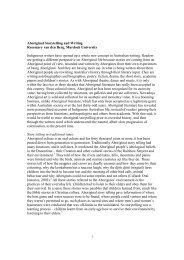Polona Petek - [API] Network
Polona Petek - [API] Network
Polona Petek - [API] Network
Create successful ePaper yourself
Turn your PDF publications into a flip-book with our unique Google optimized e-Paper software.
<strong>Polona</strong> <strong>Petek</strong>the same explanation of the emergence of homosexual desire. 21 He described hispatient’s affection for Frau K as arising from the girl’s identification with herfather and Herr K. 22 These problems aside, Freud’s text on jealousy, paranoia andhomosexuality has at least one interesting implication: without the damming up ofthe subject’s heterosexual libido, jealousy-caused homosexuality becomes asearch for one’s double.Despite the fact that Karmel’s film is generally perceived as a ‘feel-good’movie, a light-hearted romantic comedy in which nobody dies, nobody getspermanently hurt and everybody lives more or less happily ever after, the doublein Me Myself I engages seriously with Freud’s ideas of the uncanny and narcissismas well as — if not even more so — with those concerning the underlying commonfeatures of jealousy, paranoia and homosexuality. Pamela Drury’s encounters withher double — unlike most examples, which limit themselves to one aspect oranother, the choice usually dependent on the genre — stretch from ‘insuranceagainst destruction’, ‘preservation against extinction’ and possibly ‘assurance ofimmortality’ to an ‘uncanny harbinger of death’, with death and the doubleappearing in a somewhat unusual, intriguing rather than confused, order. 23Pamela’s first encounter with her look-alike happens almost immediately after herfailed attempt at suicide, the common narrative resolution of classical talesinvolving the motif of the double. 24 The event is built up to in a rather absurdmanner. After confiding in her best (and happily married and procreating)girlfriend Terry (Rebecca Frith) about a clairvoyant’s mistaken information thatshe too should be ‘happily married with two kids by now’, Pamela meets BenMunro (Sandy Winton), a too-good-to-be-true embodiment of all her expectations,only to be even more disappointed when she sneaks upon him and discovers thather latest Mr Right comes complete with two children and a partner. Convincedthat there is nothing left to live for, Pamela is just about to drop her hair-dryer intothe bathtub when a stroke of lightning cuts off the power supply and thusterminates her wretched suicide attempt. Evidently not announcing Pamela’sdeath, her double appears the very next morning. However, the encounter isanything but pleasant and reassuring. Utterly upset by a religious propagator’senquiry if she considers herself happy, Pamela makes a dash for the street and isinstantly hit by a car. The driver is none other than Pam herself, her other self, onlythis one is married to Robert Dickson. When the ‘original’ Pamela regainsconsciousness, the first thing she asks her doppelgänger is ‘Am I dead?’.Me Myself I’s double thus retains the ambiguity of the Freudian uncannyapparition while it renounces its more ominous aspect. This, however, would notquite suffice to render this particular double exceptional, for Freud himself readilyadmits, ‘Not everything that fulfils this condition — not everything that recallsrepressed desires and surmounted modes of thinking belonging to the prehistoryof the individual and of the race — is on that account uncanny’. 25 And, he adds,‘a great deal that is not uncanny in fiction would be so if it happened in real life’,for in fiction, and cinema, we ‘adapt our judgement to the imaginary realityimposed on us by the writer’ and — it must be emphasised — the genre. 26 Themore remarkable aspect of Me Myself I’s portrayal of doubles becomes evidentwhen the striking resemblances between the film’s plot and the processes andmechanisms that Freud had identified in jealousy, paranoia and homosexuality are163


![Polona Petek - [API] Network](https://img.yumpu.com/40542952/5/500x640/polona-petek-api-network.jpg)
![Dream and Nightmare in William Gibson's ... - [API] Network](https://img.yumpu.com/49298598/1/184x260/dream-and-nightmare-in-william-gibsons-api-network.jpg?quality=85)

!['Fuck All Editors': The Ern Malley Affair and Gwen ... - [API] Network](https://img.yumpu.com/42446228/1/184x260/fuck-all-editors-the-ern-malley-affair-and-gwen-api-network.jpg?quality=85)
![to download as a PDF. - [API] Network](https://img.yumpu.com/35170825/1/184x260/to-download-as-a-pdf-api-network.jpg?quality=85)
![Edward Koiki Mabo: The Journey to Native Title - [API] Network](https://img.yumpu.com/33197148/1/184x260/edward-koiki-mabo-the-journey-to-native-title-api-network.jpg?quality=85)
![Gallipoli, Kokoda and the Making of National Identity - [API] Network](https://img.yumpu.com/31766380/1/184x260/gallipoli-kokoda-and-the-making-of-national-identity-api-network.jpg?quality=85)
![Indigenous Knowledge and Pharmaceuticals - [API] Network](https://img.yumpu.com/24108846/1/184x260/indigenous-knowledge-and-pharmaceuticals-api-network.jpg?quality=85)
![Ferals: Terra-ism and Radical Ecologism in Australia - [API] Network](https://img.yumpu.com/13809010/1/184x260/ferals-terra-ism-and-radical-ecologism-in-australia-api-network.jpg?quality=85)
![Big Chief Little Wolf: Wrestling, Radio and Folklore in ... - [API] Network](https://img.yumpu.com/12204748/1/184x260/big-chief-little-wolf-wrestling-radio-and-folklore-in-api-network.jpg?quality=85)
![Dark Tourism and the Celebrity Prisoner - [API] Network](https://img.yumpu.com/4348795/1/184x260/dark-tourism-and-the-celebrity-prisoner-api-network.jpg?quality=85)